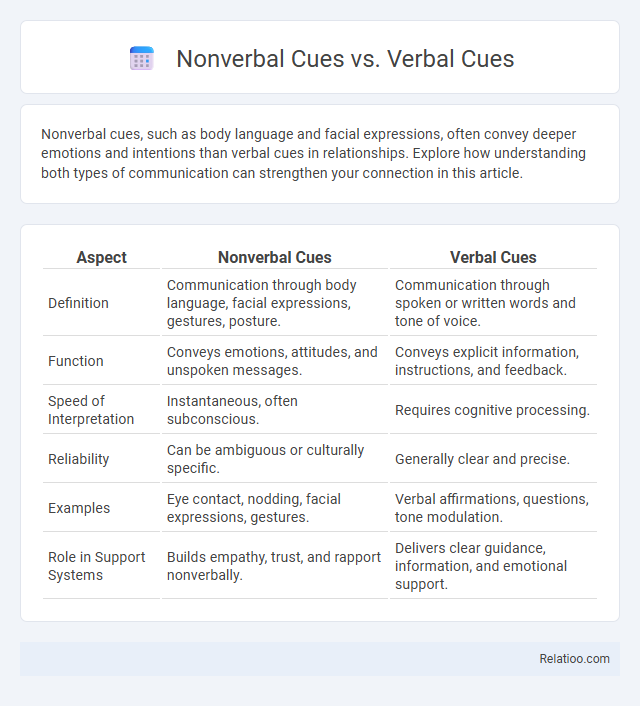Nonverbal cues, such as body language and facial expressions, often convey deeper emotions and intentions than verbal cues in relationships. Explore how understanding both types of communication can strengthen your connection in this article.
Table of Comparison
| Aspect | Nonverbal Cues | Verbal Cues |
|---|---|---|
| Definition | Communication through body language, facial expressions, gestures, posture. | Communication through spoken or written words and tone of voice. |
| Function | Conveys emotions, attitudes, and unspoken messages. | Conveys explicit information, instructions, and feedback. |
| Speed of Interpretation | Instantaneous, often subconscious. | Requires cognitive processing. |
| Reliability | Can be ambiguous or culturally specific. | Generally clear and precise. |
| Examples | Eye contact, nodding, facial expressions, gestures. | Verbal affirmations, questions, tone modulation. |
| Role in Support Systems | Builds empathy, trust, and rapport nonverbally. | Delivers clear guidance, information, and emotional support. |
Understanding Nonverbal and Verbal Cues
Understanding nonverbal and verbal cues is essential for effective communication, as nonverbal cues include body language, facial expressions, and gestures that convey emotions and intentions without words. Verbal cues consist of tone, pitch, and choice of words that provide clarity and context to your message. Mastering both types of cues enhances your ability to interpret meaning accurately and respond appropriately in various social and professional interactions.
Key Differences Between Nonverbal and Verbal Communication
Nonverbal communication relies on body language, facial expressions, gestures, posture, and eye contact to convey messages without words, while verbal communication uses spoken or written language to express ideas and information. The key differences include immediacy and clarity: verbal cues provide explicit content and are structured by grammar, whereas nonverbal cues offer implicit emotional context and can vary widely across cultures. Understanding these distinctions is critical for effective interpersonal communication and helps interpret underlying meaning beyond spoken words.
Types of Nonverbal Cues in Interaction
Nonverbal cues in interaction include facial expressions, gestures, posture, eye contact, proxemics, and paralanguage, all of which convey emotions and intentions beyond spoken words. Verbal cues consist of tone, pitch, volume, and speech rate, influencing the interpretation of the message. Understanding types of nonverbal cues enhances communication clarity by complementing or contradicting verbal messages during interpersonal exchanges.
Common Forms of Verbal Cues
Common forms of verbal cues include tone of voice, pitch, volume, and speech rate, which significantly influence the clarity and emotional impact of your message. These cues help convey intent, emphasize key points, and regulate the flow of conversation alongside verbal content. Understanding and effectively using verbal cues enhances communication by complementing nonverbal signals such as facial expressions and body language.
The Role of Body Language in Communication
Body language plays a crucial role in communication by conveying emotions and intentions beyond spoken words. Nonverbal cues such as facial expressions, gestures, and posture often reveal your true feelings and reinforce or contradict verbal messages. Understanding the interplay between verbal cues and nonverbal signals enhances clarity and helps interpret the full meaning of interactions.
Tone of Voice: A Bridge Between Verbal and Nonverbal
Tone of voice serves as a critical bridge between verbal cues--words and language--and nonverbal cues such as facial expressions and body language, enhancing your message's emotional depth and clarity. It conveys intentions, emotions, and attitudes beyond the literal meaning of words, making communication more effective and nuanced. Mastering the subtleties of tone transforms how your verbal and nonverbal signals align, improving interpersonal understanding and connection.
Cultural Variations in Communication Cues
Cultural variations significantly influence the interpretation of nonverbal cues such as gestures, facial expressions, and personal space, which can differ widely between societies and impact communication effectiveness. Verbal cues, including tone, pitch, and speech patterns, also vary culturally, shaping the meaning and perception of spoken messages. Understanding these differences is essential for cross-cultural communication, as misinterpretation of nonverbal and verbal signals can lead to misunderstandings and conflicts.
The Impact of Nonverbal Cues in Workplace Settings
Nonverbal cues in workplace settings, such as body language, facial expressions, and tone of voice, significantly influence communication effectiveness and employee relationships. Research shows that over 70% of workplace communication is nonverbal, making these signals critical for conveying trust, confidence, and engagement. Understanding and interpreting nonverbal cues alongside verbal messages enhances teamwork, reduces misunderstandings, and improves leadership impact.
Misinterpretations: When Cues Lead to Confusion
Misinterpretations often arise when nonverbal cues conflict with verbal cues, causing confusion in communication. Your intended message can become unclear if facial expressions, gestures, or tone do not align with spoken words. Understanding the distinct roles of nonverbal and verbal cues is essential to avoid mixed signals and ensure accurate interpretation.
Enhancing Communication Skills: Balancing Verbal and Nonverbal Cues
Effective communication relies on a balanced integration of verbal cues, such as tone and word choice, and nonverbal cues, including body language, facial expressions, and eye contact. Mastering the synchronization of these cues enhances clarity, emotional connection, and message impact in interpersonal interactions. Developing awareness of nonverbal signals alongside verbal articulation strengthens overall communication skills, fostering trust and reducing misunderstandings.

Infographic: Nonverbal Cues vs Verbal Cues
 relatioo.com
relatioo.com